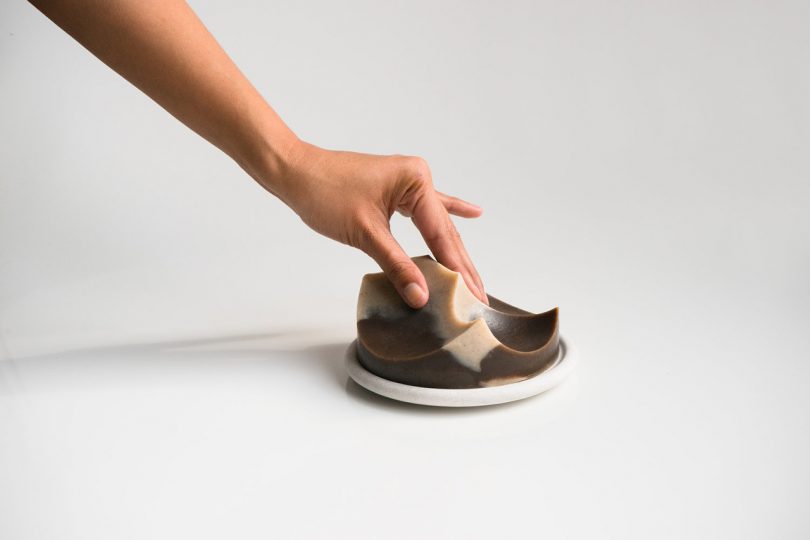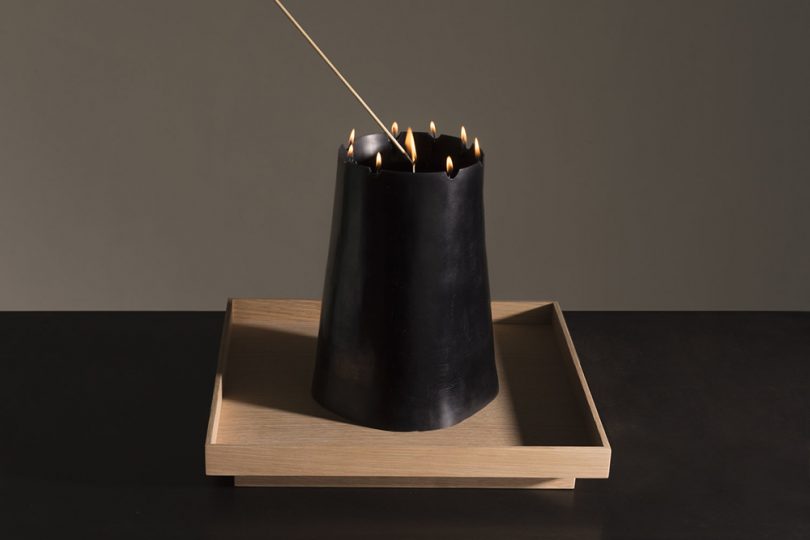The following post is brought to you by Squarespace. Our partners are hand picked by the Design Milk team because they represent the best in design.
If you’ve ever seen or experienced the tactile Erode Soap Summit Series (above), chances are you’ve already stepped into the world of UMÉ. Founded by Victor Lefebvre and Mei-Lan Tan, UMÉ is a multi-disciplinary design practice that blurs the boundaries of art, craft, and experience with products that are created in partnership with artisans around the world. Lefebre and Tan draw upon a diversity of skills, perspectives, and traditions when creating their products. It is this spirit of curiosity, as well as their willingness to throw out convention while honoring tradition, that informs everything they do today.
Lefebre and Tan worked together in architectural practices for years prior to starting UMÉ, sharing an interest in designing objects via curated spatial experiences. It was their shared design ethos for materiality, craft, and technique leading to design, rather than the norm of design informing craft and technique, that finally led them to start their studio – UMÉ. The studio focuses on high-quality design pieces that are thoughtfully developed and released periodically throughout the year.
“We originally wanted to develop a line of products to support a new type of hospitality experience,” Tan said, when sharing how the partnership began. “UMÉ was the lovechild of this idea.” She says the studio still runs on the same principle, that “the experience of space is the sum of the experiences given by both objects and spatial composition.” UMÉ focused on the object component of work at first, but the two partners recently switched their attention back to architecture, which they call the pursuit of design of objects and space as a whole.
Lefebre and Tan find their personal roots in Asia, Europe, and the United States, so they wanted to create a name that would be easy to identify and pronounce in their collective languages. Lefebre, who lived in Japan for three years, suggested the word ‘ume,’ which is a species of Asian plum. And with the addition of an accent mark, a nod to french influence in their work, UMÉ was born.
Both have put in the hard work required to turn their business into a reality, choosing Squarespace’s all-in-one platform to assist with UMÉ’s online presence and e-commerce.
“Squarespace has very much been part of growing our business since day one. We started with one of the standard templates and have been evolving the site ever since. When we felt we were outgrowing our original website, the possibility to develop a new one in preview mode helped us figure out what we needed. It also enabled us to work on the new website while keeping everything open, and switch seamlessly over when we were ready. The integration of the business platform is very well made, and the connection to all of our devices is helpful in tracking orders, inventory, and managing our workload,” Tan said of their experience.
UMÉ has partnered with a variety of international designers and artisans since their inception. The studio is especially attracted to individuals who have personalities as inspiring as their craftsmanship. “People who are open and share a passion for learning, crafting, and exchanging make the group of people behind UMÉ,” Tan shared. “This idea of exchange is really what defines what happens in our partnerships.”
Over time, UMÉ has created many incredible projects, with one standing out among the others. Erode is a series of hand soaps in unique shapes, poured by hand so that no two are ever the same. A formula of botanicals, antioxidants, mineral rich clays, and skin-nurturing essential oils work together to cleanse, hydrate, and nourish all skin types.
“After all these years, my favorite is probably still Erode, simply because it taught us so much on so many levels,” Tan shared. “We came into this industry with the minds of artists, and developing the soap taught us how wrong and unprepared we were. It was an instant success, and it really challenged us right away.” The challenges, she shared, taught them everything about packaging, marketing, the supply chain, shipping – every single thing that makes a product a product and not just a shop model. “As we grow it still challenges us, and we grow together and learn along the way.”
“Designing is this thing that is part of your life and consumes you, you don’t look for inspiration but it gets absorbed everywhere you go – online, friends, the objects around us, travels,” Tan says of the influence behind UMÉ’s work. “Travel has been a very important part of UMÉ. We took a year to travel in France, Japan, and Bali in an exercise of “nomadic design.” We met craftsmen, made friends, and developed products from these experiences. A lot of our objects still feed from this time. A good example is the Sake Tampo cup, which is a traditional Japanese cup that we revisited, and is handcrafted in silver in Indonesia.”
Tan and Lefebre design for themselves as much as others, and say they wouldn’t create anything for UMÉ that they wouldn’t use at home in their own everyday lives. “We love to be surrounded by objects, things we gather from travels, designers, and products we love. There is a constant rotation of objects that we both live with and observe, no matter how small of a place we’ve lived in – the objects have helped define our spaces and make them feel special to us. Rotating them around, in and out, also helps us to experience them in different contexts, both in relation to one another and the space. It almost feels like an exhibition that we live in,” Tan said of their own personal spaces.
So, what’s in the works for UMÉ at the moment?
Tan let us in on what’s to come: a sofa created in partnership with Takaokaya, a traditional Futon maker in Kyoto. “The sofa works as a “wooden canvas” for a variety of japanese traditional cotton items, and borrows from ancient modes of living closer to the ground, while also being inherently modern,” Tan elaborated. “We have been working on this project for the past three years now, and it has been extremely challenging to push to the level we wanted it to be at, so we are pretty excited about the release.”
In the coming years Tan says UMÉ will keep working on product and furniture design, but envision also dedicating time to create spaces and mold their own space gradually. “We have completed a large order for the remodeling of the Uniqlo store on Powell Street in San Francisco as well as a Valextra store in Hawaii, and a little interior project for Airbnb. With the design of space, interiors, and architecture in mind, we hope to develop a studio closer to our existing methodology behind rituals.”
At the end of the day, UMÉ is a multidisciplinary practice, and like all practices, they continue to evolve. Through experimentation and a thoughtful critique of everything they design, UMÉ aims to find the space where art, craft, and their own experiences merge. Objects become experiences, while production is all about stories with a belief that products are things we buy and discard, while stories are kept and cherished.
“Switching templates so easily on Squarespace also helped us produce our identity through the site – from the balance of white space to controlling how our toolbars worked. Being a multi-disciplinary practice, it can be difficult to find a standard template that helps us communicate both our products and our limited edition items. We have begun to introduce interiors on the same site with similar templates, allowing anyone who lands on UMÉ’s site to have a better picture of what we do as a practice.”
Ready to get to work on your own site? Take the first step with a Squarespace website. Use coupon code DESIGNMILK at checkout to get 10% off your first purchase.
from WordPress https://connorrenwickblog.wordpress.com/2020/04/06/ume-throws-out-convention-while-honoring-tradition/













No comments:
Post a Comment